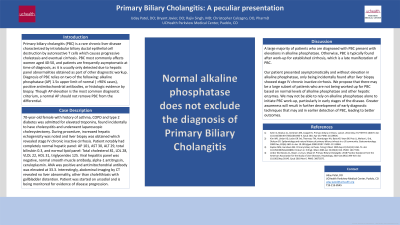Tuesday Poster Session
Category: Biliary/Pancreas
P3600 - Primary Biliary Cholangitis: A Peculiar Presentation
Tuesday, October 29, 2024
10:30 AM - 4:00 PM ET
Location: Exhibit Hall E

Has Audio

Uday Patel, DO
Parkview Medical Center
Pueblo, CO
Presenting Author(s)
Uday Patel, DO, Bryant Javier, DO, Rajiv Singh, MD, Christopher Calcagno, DO, PharmD
Parkview Medical Center, Pueblo, CO
Introduction: Primary biliary cholangitis (PBC) is a rare chronic liver disease characterized by intralobular biliary ductal epithelial cell destruction by autoreactive T cells which causes progressive cholestasis and eventual cirrhosis. PBC most commonly affects women aged 40-50, and patients are frequently asymptomatic at time of diagnosis, as it is usually only detected due to hepatic panel abnormalities obtained as part of other diagnostic workup. Diagnosis of PBC relies on two of the following: alkaline phosphatase (AP) 1.5x upper limit of normal ( >90% cases), positive antimitochondrial antibodies, or histologic evidence by biopsy. Though AP elevation is the most common diagnostic criterium, a normal AP should not remove PBC from the differential.
Case Description/Methods: 70-year-old female with history of asthma, COPD and type 2 diabetes was admitted for elevated troponins, found incidentally to have cholecystitis and underwent laparoscopic cholecystectomy. During procedure, increased hepatic echogenicity was noted and liver biopsy was obtained which revealed stage IV chronic inactive cirrhosis. Patient notably had completely normal hepatic panel: AP 101, AST 30, ALT 29, total bilirubin 0.3, and normal lipid panel: Total cholesterol 81, LDL 28, VLDL 22, HDL 31, triglycerides 125. Viral hepatitis panel was negative, normal smooth muscle antibody, alpha-1 antitrypsin, ceruloplasmin. ANA was positive and antimitochondrial antibody was elevated at 33.3. Interestingly, abdominal imaging by CT revealed no liver abnormality, other than cholelithiasis with gallbladder distention. Patient was started on ursodiol and is being monitored for evidence of disease progression.
Discussion: A large majority patients who are diagnosed with PBC present with elevations in alkaline phosphatase. Otherwise, PBC is typically found after work-up for established cirrhosis, which is a late manifestation of PBC.
Our patient presented asymptomatically and without elevation in alkaline phosphatase, only being incidentally found after liver biopsy showed stage IV chronic inactive cirrhosis. We propose that there may be a large subset of patients who are not being worked up for PBC based on normal levels of alkaline phosphatase and other hepatic enzymes. We may not be able to rely on alkaline phosphatase alone to initiate PBC work-up, particularly in early stages of the disease. Greater awareness will result in further development of early diagnostic techniques that may aid in earlier detection of PBC, leading to better outcomes.
Disclosures:
Uday Patel, DO, Bryant Javier, DO, Rajiv Singh, MD, Christopher Calcagno, DO, PharmD. P3600 - Primary Biliary Cholangitis: A Peculiar Presentation, ACG 2024 Annual Scientific Meeting Abstracts. Philadelphia, PA: American College of Gastroenterology.
Parkview Medical Center, Pueblo, CO
Introduction: Primary biliary cholangitis (PBC) is a rare chronic liver disease characterized by intralobular biliary ductal epithelial cell destruction by autoreactive T cells which causes progressive cholestasis and eventual cirrhosis. PBC most commonly affects women aged 40-50, and patients are frequently asymptomatic at time of diagnosis, as it is usually only detected due to hepatic panel abnormalities obtained as part of other diagnostic workup. Diagnosis of PBC relies on two of the following: alkaline phosphatase (AP) 1.5x upper limit of normal ( >90% cases), positive antimitochondrial antibodies, or histologic evidence by biopsy. Though AP elevation is the most common diagnostic criterium, a normal AP should not remove PBC from the differential.
Case Description/Methods: 70-year-old female with history of asthma, COPD and type 2 diabetes was admitted for elevated troponins, found incidentally to have cholecystitis and underwent laparoscopic cholecystectomy. During procedure, increased hepatic echogenicity was noted and liver biopsy was obtained which revealed stage IV chronic inactive cirrhosis. Patient notably had completely normal hepatic panel: AP 101, AST 30, ALT 29, total bilirubin 0.3, and normal lipid panel: Total cholesterol 81, LDL 28, VLDL 22, HDL 31, triglycerides 125. Viral hepatitis panel was negative, normal smooth muscle antibody, alpha-1 antitrypsin, ceruloplasmin. ANA was positive and antimitochondrial antibody was elevated at 33.3. Interestingly, abdominal imaging by CT revealed no liver abnormality, other than cholelithiasis with gallbladder distention. Patient was started on ursodiol and is being monitored for evidence of disease progression.
Discussion: A large majority patients who are diagnosed with PBC present with elevations in alkaline phosphatase. Otherwise, PBC is typically found after work-up for established cirrhosis, which is a late manifestation of PBC.
Our patient presented asymptomatically and without elevation in alkaline phosphatase, only being incidentally found after liver biopsy showed stage IV chronic inactive cirrhosis. We propose that there may be a large subset of patients who are not being worked up for PBC based on normal levels of alkaline phosphatase and other hepatic enzymes. We may not be able to rely on alkaline phosphatase alone to initiate PBC work-up, particularly in early stages of the disease. Greater awareness will result in further development of early diagnostic techniques that may aid in earlier detection of PBC, leading to better outcomes.
Disclosures:
Uday Patel indicated no relevant financial relationships.
Bryant Javier indicated no relevant financial relationships.
Rajiv Singh indicated no relevant financial relationships.
Christopher Calcagno indicated no relevant financial relationships.
Uday Patel, DO, Bryant Javier, DO, Rajiv Singh, MD, Christopher Calcagno, DO, PharmD. P3600 - Primary Biliary Cholangitis: A Peculiar Presentation, ACG 2024 Annual Scientific Meeting Abstracts. Philadelphia, PA: American College of Gastroenterology.
